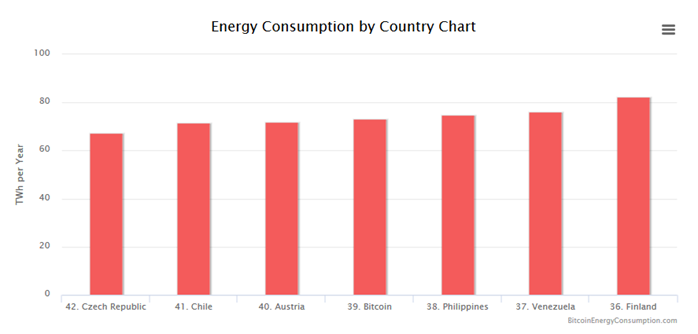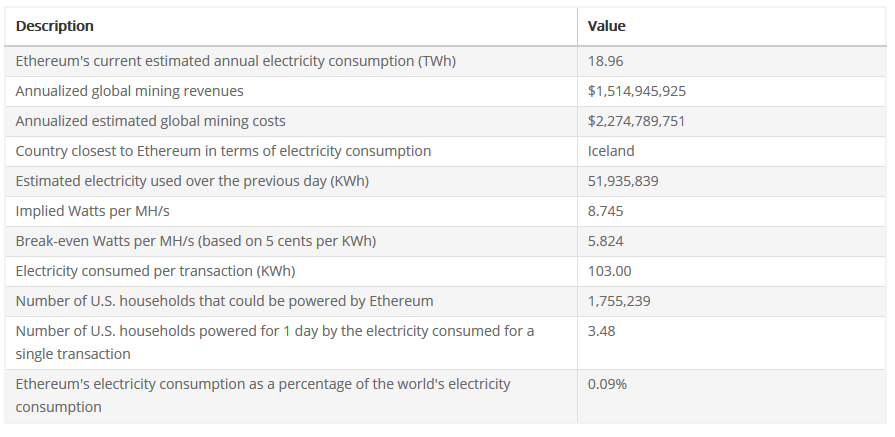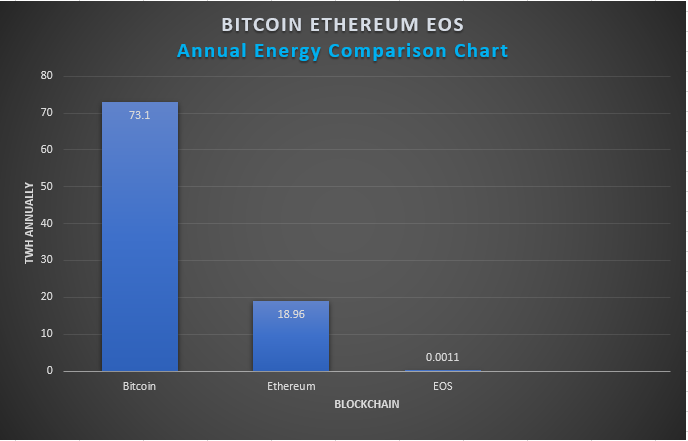
译文/Translated:
本文中我们将对比比特币及以太坊等加密货币的工作量证明(POW),继而探究使用委任权益证明(DPOS)的EOS。经此比较,我们欲推动能源消耗与区块链合约关联。
众多区块链在能源消耗上有着实质上的区别。正如我们所知,比特币拥有加密货币的最高市值,并以其惊人的能源消耗而闻名。世界的焦点已经转移至可持续性,以及如何使用绿色产业降低碳足迹,缓解地球的气候改变。区块链不能置身事外,而应该引领其道。
比特币
比特币持有众多能量消耗的研究报告和计算,它采用POW(工作量证明)机制,该机制费时费力。它有效消耗电量相当于阿根廷整个国家的电力消耗量。这个数字具体是多少?是巨大的73.1千瓦时*。如此大的电量足以支撑非洲的电力消耗,并且是美国年消耗量的1.5%。下图展示了比特币消耗的巨大电量。
国家电力消耗与比特币电力消耗


有趣的是,比特币能源消耗甚至不算它最大的问题。比特币的主要矿业公司在中国使用燃煤发电。燃煤供电在中国价格低廉,这让每一笔比特币交易都附有不可置信的巨大碳足迹。矿业加密货币以惊人的70%份额支配着该市场。
以太坊
以太坊市值排名第二,近年来,以太坊面向民众推出了众多项目。作为一个开发者能在其上创建智能合约的去中心化平台,以太坊是一个范围巨大的区块链,它能够添加价值,并代表项目,资产以及DAPP开发的所有权。
它的方向或许是正确的,因为以太坊的亿千瓦时水平明显低于比特币,但它的电力消耗仍然巨大。参阅以下图片,了解更多数据。

比特币及以太坊都消耗着大量的电力,请参阅以下将双方电力消耗合并的表格。

EOS
EOS为区块链3.0,它要求遵循并提供新型区块链代理在所有领域应当提供的内容.EOS是基于Graphene(石墨烯)技术,正如其前辈的Steemit&Bitshares.EOS凭借自身多线处理能力,采用了委托证明共识算法(DPOS).EOS踌躇满志,绝对能在所有需要它的所有领域发挥其作用。
EOS网络与21位推选的区块制作者一起运行操作,同时有53位预备区块制作者准备就绪,依照代币持有者的投票可随时就位。
EOS 能源分解
若我们加上21位首席和53位预备候选,这就相当于74 BP。
一位区块链制作者24小时平均耗能为1.8千瓦。因此,1.8千瓦X 24 X 74 = 3196千瓦时/日。
3196千瓦时X 365天(每年)= 1,137,776千瓦时
转换为太瓦时则为0.0011太瓦时
基于以上计算,EOS能效超比特币66000倍。这些结论让我们看到,EOS(DPOS)正是那个革新者。低能耗同时拥有坚固的速度基础。
比特币与EOS的不同之处。73.1太瓦时/0.0011太瓦时= 66,454(倍),EOS拥有比特币66,454倍能效,是以太坊的17,236倍。

关于我们
GenerEOS是社会企业区块,以提升并支持可扩展且高度可信赖的区块产生为己任,由此产生候选人,同时将区块应用于社会实事件中,回馈社会。
GenerEOS总部设在澳大利亚悉尼之外,由一群背景各异,但趣味相投的区块链爱好者成立,他们怀抱一腔热诚,想干出一番别样天地,并以回馈的方式培养慷慨的精神。
给予的未来
原文/Original:
In this article we look at the comparisons of Proof of Work (POW) crypto-currencies such as Bitcoin & Ethereum then delve into EOS which uses Delegated Proof Of Stake (DPOS). In these comparisons, it’s our intention to bring forward the realization of energy consumption associated with blockchain protocols.
Many blockchains have substantial differences in energy consumption. As we know, Bitcoin has the highest market cap of any cryptocurrency, yet is renowned for its aggressive energy consumption. The world’s focus has moved to sustainability and how green industries can be used to reduce our carbon footprint and save our planet from climate change. The blockchain is not excluded from this and should lead from the front.
BITCOIN
Bitcoin holds numerous research papers and calculations based on it’s energy consumption. Bitcoin uses a POW (Proof Of Work) mechanism that’s costly and time-consuming to produce. It effectively consumes the same amount of electricity as the nation of Argentina. How much electricity is that? It’s a whopping 73.1 TWh*. That’s enough to cover the electricity use in Africa and is 1.5% of the United States yearly consumption. Below is a chart that shows how high Bitcoin ranks in electricity consumption.
Country Consumption of Electricity VS Bitcoin


Funnily enough Bitcoins energy consumption is not even the biggest problem. Bitcoins top miners operate using coal-fired power plants in China. Coal-based electricity is available there at low rates & this delivers the ridiculous carbon footprint for each unique Bitcoin transaction. Mined crypto-currencies dominate the market by a staggering 70%.
ETHEREUM
Ranked at no.2 in market cap, Ethereum has brought a lot to the masses in recent years. Being a decentralized platform where developers can create smart contracts, Ethereum is a blockchain with an enormous reach that can add value and represent the ownership of items, property & dApp development.
It’s a step in the right direction as it has a significantly lower TWh level than Bitcoin but still breeds crazy levels of electricity consumption. See the image below for more statistics.

Bitcoin and Ethereum are large consumers of electricity, have a look at their combined usage in the image below.

EOS
EOS is blockchain 3.0 that demands respect and delivers in all fields respectively to what a new blockchain agent should deliver. EOS is based on Graphene technology as its predecessor’s Steemit & Bitshares. With its multi-lane processing capacity using Delegated Proof of Stake consensus algorithm (DPoS), EOS breathes fire and definitely delivers in all areas where it needs.
The EOS network operates with 21 elected Block Producers and 53 stand by Block Producers ready to stand in at any point as voted by token holders.
EOS Energy Breakdown
If we add the top 21 and 53 standby candidates, this equates to 74 BP’s.
Average energy consumption for a Block Producer is 1,8KW for 24 hours. Therefore, 1.8KW x 24 x 74 = 3196 kWh per day.
3196 kWh x 365 days for Annual Use = 1,137,776 kWh
Converting 1,137,776 kWh into TWh = 0.0011 TWh
Based on these calculations EOS is 66,000 times more energy efficient than Bitcoin. With these types of results, we can see that EOS (DPoS) is a game changer. Holding itself with low power consumption yet delivering speed with a solid foundation.
To find the difference with Bitcoin vs EOS.
73.1 TWh / 0.0011 TWh = 66,454 times that EOS is more Energy efficient in comparison to Bitcoin & 17,236 times more Energy efficient than Ethereum.

About Us
GenerEOS is a social enterprise block producing candidate with a mission of promoting and supporting scalable and highly reliable block production whilst giving back block rewards to Social Causes.
Based out of Sydney, Australia, GenerEOS is founded by a team of likeminded blockchain enthusiasts with diverse backgrounds and a passion to make a difference in the world and fostering the spirit of generosity by giving back
The Future of Giving
原文链接/Original URL: